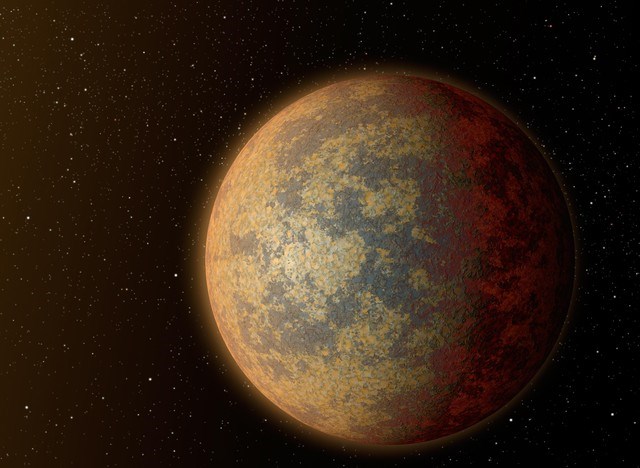What new planet is '2nd Earth'?
Although it is expected to be the most Earth-like planet with an extremely close distance, HD 219134b is still unable to "match" the Kepler-452b "Earth version 2.0".
Kepler-452b or HD 219134b more like Earth?
According to the Sci-news, NASA has discovered a new planet very similar to Earth thanks to the Spitzer space telescope, dubbed HD 219134b with the most noticeable feature being just Earth. 21 light years.
HD 219134b is a planet in the star called HD 219134. According to scientists, the star HD 219134 (also known as HR 8832) is a fifth dwarf dwarf star in the constellation. Thien Hau (Cassiopeia) and only 21 light-years away from our Earth.
The star system HD 219134 has three planets that are considered "super-Earth" because all three have larger weights and dimensions than Earth.

Planetary simulation image HD 219134b
" Super-Earth" is called HD 219134b, which is about 4.5 times heavier and 1.6 times larger than Earth, considered the most Earth- like planet .
Astronomers predict that the planets may have rocks and a melting surface with geological activities, including volcanoes. In addition, the scientists said that if these three planets are coincident in a co-conformation configuration, they may cross each other.
Earlier on July 23, the whole world was shaken when NASA announced the planet's most widely -regarded planetary information - nicknamed Kepler-452b.
The planet is also named " Earth version 2.0" by scientists "because it meets all the conditions to survive life as it does on Earth," he said. surface structure, gravity, light, changing seasons .
Dr Daniel Brown, an astronomer at Nottingham Trent University, said: " The Kepler-452b planet receives the same spectrum and intensity of light as our Earth receives from the sun. That means plants from our planet can grow here if there are rocks and air. "

Planetary simulation image HD 219134b revolves around the mother star.
A lot of people have heard about this second version of Earth and hoped to set foot once in a lifetime.
However, before the news that Kepler-452b is 1,400 light-years from Earth and if traveling at nearly 60,000 km / h it takes 25.8 million years to arrive, they must give up this hope soon. .
Until the discovery of "super-Earth" HD 219134b and the information that the planet was only 21 light-years from Earth, the desire could live on another planet outside the universe in the future. again boomed strongly.
However, according to information on the Independent page, after NASA scientists announced the planet HD 219134b, they must immediately stress that if Kepler-452b is considered the " twin brother" of the Earth This information is only called a " cousin".
Astronomers say HD 219134b is a rocky planet, meaning Earth-like planets but hard surfaces with high specific gravity, high in iron and metal.
Although it is also very potential for life to exist, HD 219134b is too close to its parent star , and it takes only 3 days to complete a rotation.

Images of the constellation and planetary system HD 219134 (circled area).
Anyway, the planet's mother HD 219134b is smaller, lighter and colder than the Sun but because of the proximity, the temperature it absorbs will be very large.
Researchers hope to have more telescopes capable of participating in the study of the existence of life on the planet HD 219134b, especially when the planet has an advantage of being very close to the Earth. land.
With more updated data, scientists also hope to be able to detect the atmosphere of HD 219134b if available.
Michael Werner, a Spitzer mission scientist at NASA's Jet Propulsion Laboratory, said: ' This planet will be one of the most studied subjects in the next several decades.' The fact that it is very close to us will bring even more attention than Kepler-452b and make it to the potential exploration list.
Therefore, although Kepler-452b could not take the second or " ideal " Earth version to be able to live in the future, HD 219134b is still expected to bring new discoveries to the people. type, and especially humans can fully observe this planetary system with the naked eye through a telescope from Earth.
- The most Earth-like planet shows up
- Your planet is closest to Earth
- Information about 'Second Earth'
- 2 copies of Earth crashed into each other, shooting debris across space
- Exotic planet like most earth ever
- Discovering the planet is very similar to the earth
- NASA claims Proxima b Earth-like planet b does not support life
- The top 5 most Earth-like planets have been discovered
- Discovering the planet can survive life
- The discovery of a rock planet is very similar to the globe
- Found a planet that can replace Earth?
- Should Mars be an independent planet or Earth's colony?
 Van Allen's belt and evidence that the Apollo 11 mission to the Moon was myth
Van Allen's belt and evidence that the Apollo 11 mission to the Moon was myth The levels of civilization in the universe (Kardashev scale)
The levels of civilization in the universe (Kardashev scale) Today Mars, the sun and the Earth are aligned
Today Mars, the sun and the Earth are aligned The Amazon owner announced a secret plan to build a space base for thousands of people
The Amazon owner announced a secret plan to build a space base for thousands of people